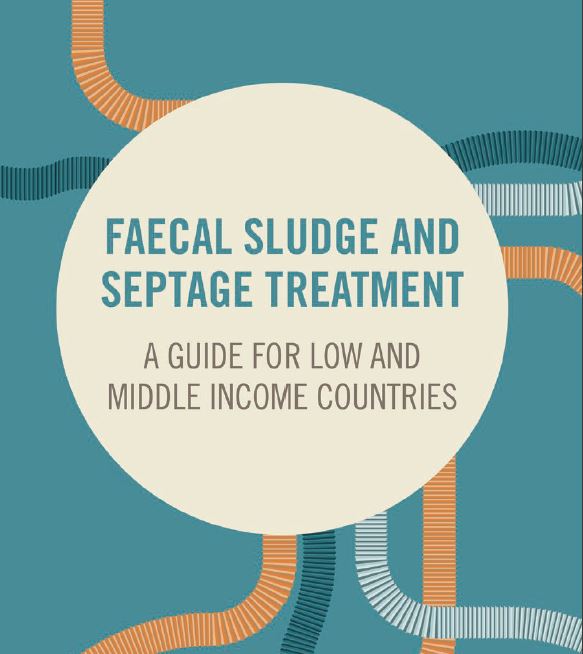Faecal Sludge and Septage Treatment. A Guide for Low and Middle Income Countries
The seed of the idea for a book such as this was planted by the Bill & Melinda Gates Foundation (BMGF) in 2010, when it asked the author to carry out a scoping study for a text book on decentralized faecal sludge management. Alyse Schrecongost managed the work on behalf of the BMGF. BMGF decided not to go ahead with the project at that stage, but it led indirectly to several years’ engagement with faecal sludge management issues in Indonesia, working with the Water and Sanitation Program (WSP) team in Jakarta. This book draws on that experience, which was facilitated by many members of the WSP team, in particular Isabel Blackett, Reini Siregar, Budi Darmawan, Maraita Listyasari, and Inni Arsyini. The book also draws on the insights and experience of Foort Bustraan and his colleagues in the USAID Indonesia Urban Water, Sanitation and Hygiene (IUWASH) team, who collaborated closely with the WSP team on investigations into aspects of faecal sludge management. Working with WSP, Freya Mills carried out work on sludge accumulation rates in pits and septic tanks, which informs Chapter 3 of the book. Andy Peal, Isabel Blackett, Peter Hawkins, Andy Cotton, and Rebecca Scott provided useful comments on an early draft of the book. Following further review of this draft by the World Bank and the BMGF, the consulting firm Stantec was engaged to contribute additional material to the book. The Stantec team contributed its knowledge of conventional and innovative treatment technologies and information on initiatives from several countries. It is largely responsible for the mathematical formulae and worked examples that guide readers through the design process. Michael McWhirter provided overall direction to the Stantec team, Chengyan Zhang led the team and was a major contributor to its input. Jeannette Laramee, Jeovanni Ayala-Lugo, Tyler Hadacek, and Mengli Shi made important contributions and Oliver Tsai, Chris Machado, and Charlie Alix also provided contributions and/or senior review. The Stantec team also contacted specialists with knowledge of specific technologies and initiatives. These included Nick Alcock and Santiago Septien for information on the black soldier fly and LaDePa system initiatives, respectively, both in eThekwini, South Africa, Andreas Schmidt for information on biodigester use and performance, Aubrey Simbambi for information on the Kanyama faecal sludge treatment plant in Lusaka, Zambia, Rohini Pradeep for information on the Devanahalli faecal sludge treatment plant performance in Bangalore, India, and Stephen Sugden for information on the Water for People biochar/pyrolysis initiative in Kenya. Particular mention must be made of Linda Strande and others at Eawag/Sandec, who provided detailed review comments on all chapters, particularly the first three chapters and the chapters on drying beds. Georges Mikhael provided information on the domed biodigester in Lusaka and the Sistema Biobolsa biodigesters in Antananarivo and Kumasi. Biodigester treatment initiatives in other locations came from various sources. Anthony Kilbride and Max Affre provided information and feedback on the SOIL bin-composting initiative in Haiti and the Sistema Biobolsa anaerobic digestion system, respectively. Information on the treatment plant in Sittwe, Myanmar, which serves camps housing internally displaced Rohingya people, was gathered in the course of a consultancy for the Paris-based NGO, Solidarités International. Thanks are due to Elio de Bonis, who was the lead consultant and Emmett Kearney, who was the main point of contact with Solidarités International in Myanmar during the consultancy and to Alberto Acquistapace, who provided information on the performance of the hopper-bottomed gravity thickener that was constructed in response to the consultancy recommendations. Teddy Gouden provided information on the latest situation with regard to the LaDePa and black soldier fly initiatives in South Africa. Ashley Muspratt checked and corrected the box on the Pivot Works initiative in Kigali. The World Bank and the BMGF provided detailed review and suggestions for improvement at all stages of the project. The review process was led and coordinated by Jan Willem Rosenboom at the BMGF and Ruth KennedyWalker and Rebecca Gilsdorf at the World Bank. Special mention should be made of Duncan Mara, Emeritus Professor at the University of Leeds in the UK, who provided a detailed review of the final draft of the book. Comments and suggestions on earlier drafts were received from both World Bank and the BMGF staff members and consultants and external specialists. World Bank reviewers included Martin Gambrill, Jean-Martin Brault, Ravikumar Joseph, Srinivasa Podipireddy, Edkarl Galing, Shafick Hoossein, Bill Kingdom, and Mutsa Prudence Mambo. BMGF reviewers included Roshan Shrestha, Dennis Mwanza, John Duffy, and Doulaye Kone. Dorai Narayana and Dave Robbins both contributed extensive comments and suggestions in their capacity as BMGF consultants. External reviewers included Linda Strande and the Eawag/ Sandec team, Professor Chris Buckley from the University of KwaZulu-Natal in South Africa, and Dave Wilson of eThekwini Water and Sanitation, Durban, South Africa. For Practical Action Publishing, Clare Tawney was a supportive content development manager at all stages of the development of the book while Chloe Callan-Foster managed the copy-editing and production process.
